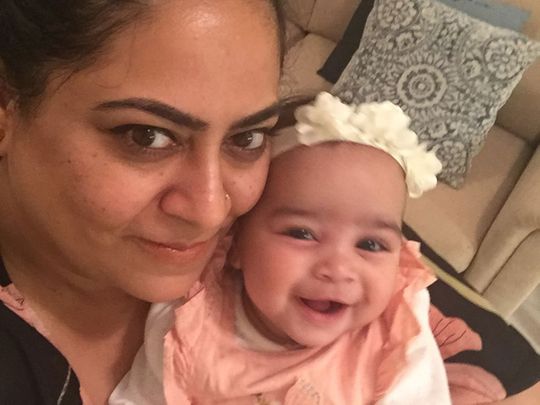
The nightmare would begin before dusk cracked the day’s façade. As the dark rolled in, it met heart-shattering cries of a newborn in pain. These wails of despair would rend through the wee hours giving way to shudders that dissolved into gentle snores.
Shilpa Sharma, an Indian expat in Dubai, recalls the horror of the first five months of having her baby home, the helplessness of her situation. Sharma says, “I saw all the doctors – took her to emergency rooms … everyone was like no it’s normal, it’s colic – you are a first-time mum so you don’t know, but this is normal. And we were like this is definitely not normal because she’s like crying eight hours – nine hours – till she’s tired and just drifting off to sleep.”
Second and third options didn’t seem to help the diagnoses and neither did following their suggestions – medicine for reflux, green bowel movements and rashes all over the body.
The one thing Sharma was told constantly was to ‘not worry’ – which did nothing to ebb her fear or calm her screaming baby. She tried colic exercises on her baby and even modified her own diet – cutting out gluten, dairy and even calcium, nothing brought relief.
What helped finally was a serendipitous run-in with a doctor who had seen similar presentations in another child – he called for a test for milk protein allergy; it was positive.
“By then we had stopped breastfeeding because she was not taking to the breast, it was as if I was putting poison to her throat – that was her reaction. That’s when we found this doctor who said she may have a milk allergy, let’s do a stool test. We did a stool test and she had a milk protein allergy. I hear it’s very common but nobody told us about it. She was allergic to milk protein, both animal and human,” she adds. They were given the name of a new formula to try – one that has broken down lipids of milk protein, resulting in the body not registering it as milk protein.
With this cycle going on, your baby is likely irritable and may seem inconsolable. Symptoms may include:
Diarrhea
Stomach inflammation and cramping
Vomiting or excessive spit ups
Blood in the stool
In severe cases, anaphylaxis, an emergency requiring immediate medical attention and a shot of epinephrine
Symptoms don’t always show up right after birth, since the body may take time to react to the protein exposure. They usually begin in an infant’s first few weeks, though, and may show up even months later.
“She immediately started showing relief,” says Sharma, her voice shaking. “She immediately started drinking that formula. She felt better from the next day. The crying was gone and she was absolutely a different baby. I still thank the doctor –he became our peadriatian. He has slowly been introducing her to a formula with more milk.
“When she turned one, we started giving her normal food. So we give her what we eat at home – rice, dal, fruits, vegetables, everything except for milk. She drinks almond milk sometimes,” she adds.
“She’s two-and-a-half now, and doing much better.”
The nights are pleasant once again – and food time’s not a chore when there’s a happy baby asking for a feed.
Lactose intolerance is common in adults – about 30 million Americans have it by age 20.
Dairy allergy involves the immune system: If you have it, your body reacts to the proteins in milk and other dairy products as if they’re dangerous invaders. It releases substances that cause allergy symptoms. This allergic reaction can be mild (rashes) to severe (trouble breathing, loss of consciousness).
Dairy allergy is one of most common allergies, especially in children. As many as 2 in every 100 children under 4 years of age are allergic to milk. It’s even more common in babies.
Source WEBMD
Have a story to share? Write to us parenting@gulfnews.com





